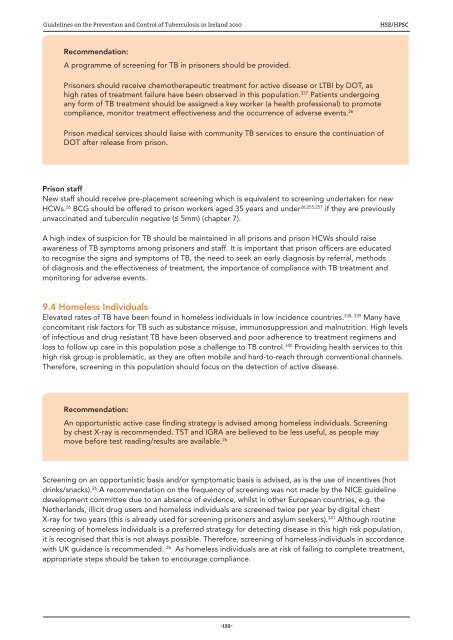Guidelines on the Prevention and Control of Tuberculosis in Ireland
Guidelines on the Prevention and Control of Tuberculosis in Ireland
Guidelines on the Prevention and Control of Tuberculosis in Ireland
You also want an ePaper? Increase the reach of your titles
YUMPU automatically turns print PDFs into web optimized ePapers that Google loves.
<str<strong>on</strong>g>Guidel<strong>in</strong>es</str<strong>on</strong>g> <strong>on</strong> <strong>the</strong> Preventi<strong>on</strong> <strong>and</strong> C<strong>on</strong>trol <strong>of</strong> <strong>Tuberculosis</strong> <strong>in</strong> Irel<strong>and</strong> 2010HSE/HPSCRecommendati<strong>on</strong>:A programme <strong>of</strong> screen<strong>in</strong>g for TB <strong>in</strong> pris<strong>on</strong>ers should be provided.Pris<strong>on</strong>ers should receive chemo<strong>the</strong>rapeutic treatment for active disease or LTBI by DOT, ashigh rates <strong>of</strong> treatment failure have been observed <strong>in</strong> this populati<strong>on</strong>. 337 Patients undergo<strong>in</strong>gany form <strong>of</strong> TB treatment should be assigned a key worker (a health pr<strong>of</strong>essi<strong>on</strong>al) to promotecompliance, m<strong>on</strong>itor treatment effectiveness <strong>and</strong> <strong>the</strong> occurrence <strong>of</strong> adverse events. 26Pris<strong>on</strong> medical services should liaise with community TB services to ensure <strong>the</strong> c<strong>on</strong>t<strong>in</strong>uati<strong>on</strong> <strong>of</strong>DOT after release from pris<strong>on</strong>.Pris<strong>on</strong> staffNew staff should receive pre-placement screen<strong>in</strong>g which is equivalent to screen<strong>in</strong>g undertaken for newHCWs. 26 BCG should be <strong>of</strong>fered to pris<strong>on</strong> workers aged 35 years <strong>and</strong> under 26;255;257 if <strong>the</strong>y are previouslyunvacc<strong>in</strong>ated <strong>and</strong> tubercul<strong>in</strong> negative (≤ 5mm) (chapter 7).A high <strong>in</strong>dex <strong>of</strong> suspici<strong>on</strong> for TB should be ma<strong>in</strong>ta<strong>in</strong>ed <strong>in</strong> all pris<strong>on</strong>s <strong>and</strong> pris<strong>on</strong> HCWs should raiseawareness <strong>of</strong> TB symptoms am<strong>on</strong>g pris<strong>on</strong>ers <strong>and</strong> staff. It is important that pris<strong>on</strong> <strong>of</strong>ficers are educatedto recognise <strong>the</strong> signs <strong>and</strong> symptoms <strong>of</strong> TB, <strong>the</strong> need to seek an early diagnosis by referral, methods<strong>of</strong> diagnosis <strong>and</strong> <strong>the</strong> effectiveness <strong>of</strong> treatment, <strong>the</strong> importance <strong>of</strong> compliance with TB treatment <strong>and</strong>m<strong>on</strong>itor<strong>in</strong>g for adverse events.9.4 Homeless IndividualsElevated rates <strong>of</strong> TB have been found <strong>in</strong> homeless <strong>in</strong>dividuals <strong>in</strong> low <strong>in</strong>cidence countries. 338, 339 Many havec<strong>on</strong>comitant risk factors for TB such as substance misuse, immunosuppressi<strong>on</strong> <strong>and</strong> malnutriti<strong>on</strong>. High levels<strong>of</strong> <strong>in</strong>fectious <strong>and</strong> drug resistant TB have been observed <strong>and</strong> poor adherence to treatment regimens <strong>and</strong>loss to follow up care <strong>in</strong> this populati<strong>on</strong> pose a challenge to TB c<strong>on</strong>trol. 340 Provid<strong>in</strong>g health services to thishigh risk group is problematic, as <strong>the</strong>y are <strong>of</strong>ten mobile <strong>and</strong> hard-to-reach through c<strong>on</strong>venti<strong>on</strong>al channels.Therefore, screen<strong>in</strong>g <strong>in</strong> this populati<strong>on</strong> should focus <strong>on</strong> <strong>the</strong> detecti<strong>on</strong> <strong>of</strong> active disease.Recommendati<strong>on</strong>:An opportunistic active case f<strong>in</strong>d<strong>in</strong>g strategy is advised am<strong>on</strong>g homeless <strong>in</strong>dividuals. Screen<strong>in</strong>gby chest X-ray is recommended. TST <strong>and</strong> IGRA are believed to be less useful, as people maymove before test read<strong>in</strong>g/results are available. 26Screen<strong>in</strong>g <strong>on</strong> an opportunistic basis <strong>and</strong>/or symptomatic basis is advised, as is <strong>the</strong> use <strong>of</strong> <strong>in</strong>centives (hotdr<strong>in</strong>ks/snacks). 26 A recommendati<strong>on</strong> <strong>on</strong> <strong>the</strong> frequency <strong>of</strong> screen<strong>in</strong>g was not made by <strong>the</strong> NICE guidel<strong>in</strong>edevelopment committee due to an absence <strong>of</strong> evidence, whilst <strong>in</strong> o<strong>the</strong>r European countries, e.g. <strong>the</strong>Ne<strong>the</strong>rl<strong>and</strong>s, illicit drug users <strong>and</strong> homeless <strong>in</strong>dividuals are screened twice per year by digital chestX-ray for two years (this is already used for screen<strong>in</strong>g pris<strong>on</strong>ers <strong>and</strong> asylum seekers). 341 Although rout<strong>in</strong>escreen<strong>in</strong>g <strong>of</strong> homeless <strong>in</strong>dividuals is a preferred strategy for detect<strong>in</strong>g disease <strong>in</strong> this high risk populati<strong>on</strong>,it is recognised that this is not always possible. Therefore, screen<strong>in</strong>g <strong>of</strong> homeless <strong>in</strong>dividuals <strong>in</strong> accordancewith UK guidance is recommended. 26 As homeless <strong>in</strong>dividuals are at risk <strong>of</strong> fail<strong>in</strong>g to complete treatment,appropriate steps should be taken to encourage compliance.-122-
















